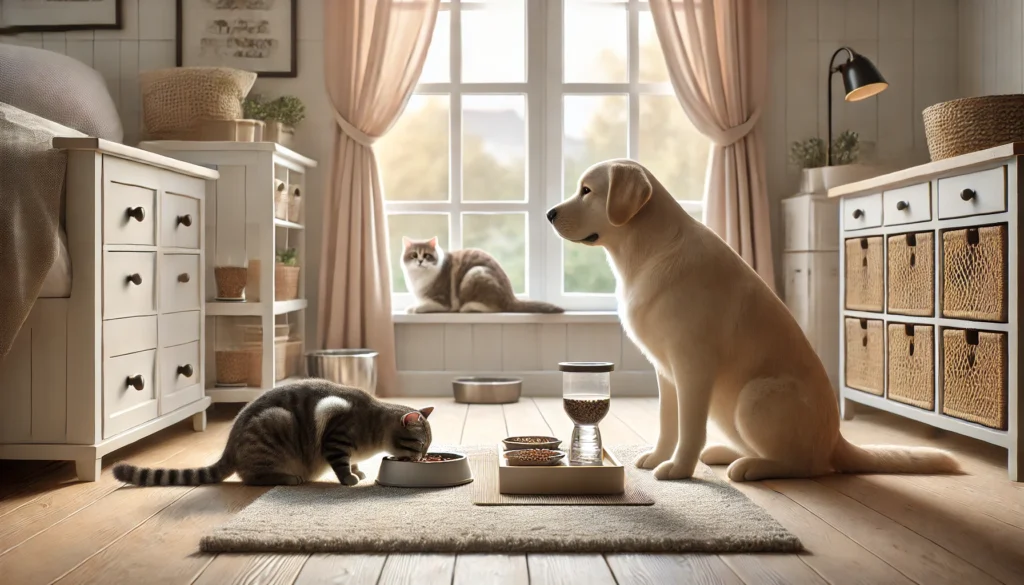Mornings set the tone for the entire day — not just for humans, but for pets as well. Dogs and cats are sensitive to daily rhythms and environmental cues. When the morning starts with tension, unpredictability, or overstimulation, it can lead to restlessness, anxiety, or unwanted behaviors throughout the day.
Creating a calm, structured morning routine for your indoor dog or cat not only improves their behavior but also supports emotional stability, trust, and your bond. This article will show you how to craft a simple, peaceful routine to start every day right — for both of you.
Why Morning Routines Matter for Pets
Like people, pets thrive on predictability. A calm and consistent morning routine can help your dog or cat:
- Feel more secure and less anxious
- Transition smoothly from rest to activity
- Understand what to expect each day
- Reduce overstimulation or demand-based behavior
- Settle more easily when you leave for work or start your day at home
A reliable routine builds emotional resilience and balance — especially important for indoor pets with limited external stimuli.
Understanding Your Pet’s Morning Needs
Before building a routine, consider what your pet naturally needs first thing in the morning:
Dogs typically need:
- Immediate potty relief
- Physical movement or a short walk
- Mental stimulation or food-based activity
- Calm guidance to avoid hyperactivity
Cats typically need:
- Early meal or snack (especially if fed on schedule)
- Litter box check-in
- Attention or affection on their terms
- A clear signal of where they fit in the household flow
Use this awareness to shape routines around their natural rhythms, not just your own schedule.
Step-by-Step Morning Routine for Dogs
Step 1: Calm Wake-Up
Avoid high-pitched voices, loud music, or jumping into play. Use a soft voice and relaxed body language. Stretch together or sit quietly before transitioning to movement.
Step 2: Quick Outdoor Break
If your dog is house-trained, offer a potty walk within the first 10–15 minutes. Keep it short, focused, and calm — save energetic play for later.
If you live in an apartment, a balcony pee pad or indoor grass patch may be necessary for quick relief.
Step 3: Light Engagement
Instead of roughhousing, offer a mental challenge. Try:
- A short training session (sit, down, wait)
- A sniff walk (on leash, slow pace)
- A food puzzle or frozen Kong for quiet focus
This balances the body and brain without overstimulating your dog.
Step 4: Breakfast and Water
Feed your dog in a calm space using a slow feeder or snuffle mat. Ensure fresh water is available.
Avoid hand-feeding or encouraging demand-based barking. Instead, use structure — ask for “wait” or “place” before feeding.
Step 5: Calm Transition
After breakfast, guide your dog to a rest area, crate, or bed. Offer a chew toy or calming treat while you get ready.
This reinforces independent calm and reduces separation anxiety if you’re leaving home.
Step-by-Step Morning Routine for Cats
Step 1: Check In Without Noise
Avoid startling your cat. Greet with slow blinks, a soft voice, and quiet movements.
Let your cat come to you before initiating interaction.
Step 2: Refresh Food, Water, and Litter
Cats expect consistency. Even if they graze throughout the day, replace dry food or serve scheduled wet meals on time.
Scoop the litter box and top off fresh water.
Step 3: Interactive Play (Short Session)
Use a wand toy or laser pointer to activate hunting instincts. Keep it short (5–10 minutes) and end with a reward or treat.
This helps prevent hyperactivity later and supports confidence in shy cats.
Step 4: Create a Daytime Space
Set up a comfortable perch or sun spot before you leave. Place a favorite blanket or rotate toys nearby.
Turn on bird TV or soft music if your cat likes background noise.
Cats prefer solitude with enrichment — not forced engagement. Leave the environment tidy and predictable.
Additional Morning Routine Enhancements
- Use calming music, nature sounds, or a white noise machine
- Add aromatherapy (lavender or chamomile — pet-safe only)
- Avoid screens or bright lights in your pet’s space
- Offer a short grooming session (brushing, wiping eyes/paws)
Keep the energy grounded — think “Sunday morning,” not “Monday rush.”
For Multi-Pet Households
If you live with both dogs and cats:
- Stagger meals to reduce chaos
- Feed cats in elevated areas or separate rooms
- Offer separate engagement (cat with wand toy, dog with puzzle)
- Monitor for competition, tension, or crowding
Structure keeps peace — and avoids food stealing or resource guarding.
Adapting Routines for Work-From-Home Life
If you’re home all day:
- Still keep feeding and play consistent
- Use signals (e.g., “settle” or closing a door) to indicate work time
- Take micro-breaks to give your pet brief attention
- Encourage naps and independent play during work blocks
Predictability supports both productivity and pet wellness.
Consistency Over Perfection
Some mornings will be rushed. That’s okay. What matters is effort and intention.
- Focus on a few key habits (calm wake-up, predictable feeding, short engagement)
- Keep things low-energy and peaceful
- Praise desired behavior and ignore attention-seeking when possible
- Adjust based on your pet’s individual personality
Your dog or cat will begin to mirror your morning vibe — calmer energy starts with you.
The Morning Mood That Lasts All Day
When pets start the day feeling safe, seen, and supported, their emotional balance carries into the afternoon and evening. They’re less likely to bark excessively, pace, beg, or demand — because their needs have been met, gently and consistently.
Build a morning that feels like a ritual, not a chore — and both you and your pet will benefit.






